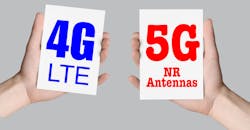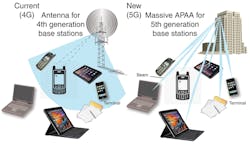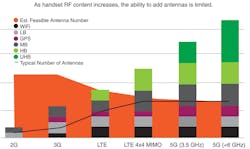Differentiate Between 4G LTE and Non-Standalone 5G NR Antennas
Download this article in PDF format.
In December 2017, the Third Generation Partnership Project (3GPP) issued Release 15, which created an early version of 5G, called 5G non-standalone (NSA). NSA 5G New Radio (NR) implements some of the key 5G application features, namely enhanced mobile broadband (eMBB) and ultra-reliable low-latency communications (URLLC), as well as detailing new sub-6-GHz frequencies and introducing millimeter-wave (mmWave) frequency bands.
Some of the methods enabling new NSA 5G NR specifications have been available in 4G LTE Advanced Pro, namely multiple-input, multiple-output (MIMO) and carrier aggregation (CA). However, Release 15 defines advanced versions of these technologies alongside the need for co-location and compatibility between 4G and 5G RF hardware.
The migration and incorporation of 4G LTE frequency bands, new technologies, new frequencies, and new methods of deployment are significantly changing NSA 5G NR antenna requirements in comparison to 4G LTE antennas. This article aims to describe how the new specifications of NSA 5G NR lead to design, performance, and infrastructure changes in the implementation of next-generation antennas for base stations and user equipment (UE).
Introduction
As stated, the key features of 3GPP Release 15 NSA 5G NR are eMBB and URLLC.1 These features are enabled by advanced antenna techniques, antenna tuning, and infrastructure changes regarding deployment of base stations and UEs. These changes directly impact antenna design and technologies, creating a rift between previous 4G LTE antennas and future 5G versions. Beyond opening up additional sub-6-GHz spectrum and assigning new mmWave spectrum for NSA 5G NR, many other operational dynamics exist that define the differences between 4G LTE and NSA 5G NR antennas (Fig. 1).
1. The 3GPP Release timeline for 5G coincides with developments of LTE, which will eventually merge, posing interim challenges for hardware manufacturers designing antennas to serve multiple specifications.
4G LTE Base-Station Antennas vs. NSA 5G NR
It’s important to note that the rollout of NSA 5G NR will likely only include the eMBB features of MIMO and CA, along with much lower latencies. And its rollout will pick up as 4G LTE continues to roll out. However, it will be several years before viable mmWave 5G is introduced. So, the upcoming NSA 5G NR base-station equipment will likely be enhanced 4G LTE technology with additional bands and features. This is the likely scenario until 3GPP Release 16 defines standalone (SA) 5G NR, in which mmWave control plane and communications occur simultaneously, SA 5G NR trials and deployments begin, and 4G LTE bands are refarmed into 5G bands as the technology generations merge.
4×4 MIMO Downlink for Base Stations
For NSA 5G NR, MIMO means more antennas, typically implemented as arrays of antennas, or similar to MIMO-capable Wi-Fi routers with several distinct external antennas. Given the cost, reliability, and size constraints for already congested tower sites and future pole and small-cell sites, NSA 5G NR base-station antennas need to be compact and integrated. Otherwise, carriers may incur additional costs for deploying complex, larger, and heavier MIMO antennas.2.1.1
As the initial rollouts of NSA 5G NR will likely be below 6 GHz, the 4G LTE base-station antennas will either be co-located or replaced with NSA 5G NR antennas that support 4G LTE bands and the new 3.5-GHz NSA 5G NR band. Also, 4×4 MIMO is required with NSA 5G NR, whereas it was optional with 4G LTE—and not all 4G LTE antennas and base-station equipment have been updated to enable MIMO.
Hence, the main differences between 4G LTE and NSA 5G NR antennas will be that NSA 5G NR antennas will incorporate 4G LTE bands, along with extended frequency operation to the 3.5-GHz band, and possibly lower frequencies to enable more CA combinations. As an interim solution, 4G LTE base stations may be augmented with wideband 3.5-GHz 4×4 MIMO antennas alongside existing 4G LTE antennas and equipment.
Micro Cells and Small Cells
Many telecom companies have already begun deploying 4G LTE pole sites, small cells, and distributed antenna systems (DASs) to provide higher throughput, lower latency, and better coverage in congested and otherwise underserved locations. As a result, a trend of deploying microsite base stations can already be seen in many regions, which will be a key dynamic of the 5G infrastructure.
Some sub-6-GHz NSA 5G NR frequencies, namely the 3.5-GHz band, are significantly higher than other 4G LTE bands. Thus, the RF signals attenuate greater and require better alignment between tower antennas and UEs than lower-frequency 4G LTE signals.
This is where a micro-site expansion to compliment macro-cell coverage is necessary to provide the promised higher throughput and lower-latency NSA 5G NR performance. Micro-cell/small-cell antennas are typically more integrated than larger base-station types. And they may only include the higher-frequency 4G LTE bands and new 3.5-GHz NSA 5G NR band, as nearby macro cells could accommodate lower-priority communications and legacy features.
Many 4G LTE antennas for small cells offer a narrow range of bands. NSA 5G NR micro sites and small cells, on the other hand, will need to field antennas that can serve several of the higher frequency and bandwidth 4G LTE and NSA 5G NR frequencies in more compact packages.
Massive MIMO
One of the future 5G applications is massive MIMO, where a single base-station system can support tens to hundreds of user devices (Fig. 2). This feature enables massive machine type communications (mMTC). A key aspect of massive MIMO is advanced antennas with complex digital beamforming, or hybrid analog/digital beamforming, and large antenna arrays.
2. 5G massive MIMO requires active antennas with advanced beamforming technologies to direct narrow beams to stationary and moving targets in real time.
For future mmWave NSA 5G NR, an active antenna array with tens to hundreds of elements is only a few inches on a side. For sub-6-GHz frequencies, an active antenna array with a similar number of elements will typically exceed 15 in. on a side, leading to much larger antenna structures for sub-6-GHz massive MIMO. With Release 15, massive-MIMO antenna systems are extended to support a maximum of 256 antenna elements, compared to 64 elements in Release 13.
This contrasts with commonly deployed 4G LTE antennas, which are discrete and not designed with consideration to massive-MIMO applications until Release 13 (which is largely unrealized). Also, with lower-frequency 4G LTE, the antennas typically have lower directivity than higher-frequency NSA 5G NR bands.
Though higher directivity can improve signal propagation to a specific target, serving several moving targets within a region pose a challenge. Hence, NSA 5G NR antenna systems will likely need to be active arrays with some level of steering to account for a new 3D spatial dynamic.2.2.2 This is especially true for mmWave 5G, where the antenna beams are extremely narrow compared to sub-6-GHz frequencies, and will need to accurately track several moving targets simultaneously.
User Equipment/Handset Antennas
Many hardware manufacturers designate next year, 2019, to produce the first 5G smartphones. These devices will only be augmented 4G LTE smartphones enhanced with 3.5-GHz NSA 5G NR capacity.3.1.1 However, the RF front-end (RFFE) is already a complex combination of densely integrated antennas, antenna tuners, and RF chips. An additional extremely wideband 3.5-GHz antenna would exceed the available space requirements of most flagship smartphones already boasting a wide range of 4G LTE bands. Thus, NSA 5G NR smartphones may be equipped with antenna technologies capable of serving older-generation and NSA 5G NR bands.
4×4 Downlink MIMO for Handsets, Antenna Tuning, and Latency
NSA 5G NR requires twice the number of downlink (DL) MIMO antennas in a handset, which may be a significant consideration when 4G LTE bands are refarmed to 5G bands. Some handset manufacturers have already addressed this challenge by adopting 4×4 MIMO for the DL. However, even these pioneers must address the 2×2 MIMO uplink (UL) requirement for 5G NR bands n77, n78, n79, and n41.
These new requirements translate to a total of three extra antennas, RFFEs, and subsequent interconnect and RF pathways—even more if separate RF hardware and antennas are used for the 3.5-GHz NSA 5G NR bands and 4G LTE bands. Doubling, or more, the number of antennas compared to 4G LTE also increases the need for wider-bandwidth antennas and more capable antenna tuning and antenna multiplexers.
4G LTE handsets use fast-switching antenna tuning units closely coupled to the several prior-generation and 4G LTE antennas included in a handset. This antenna-tuning technology and antennas, along with their filters, are designed around a much more forgiving latency specification (about 10 ms) than the new NSA 5G NR specifications (1 ms). Hence, future 5G smartphones will require much faster antenna tuners, which can also tune over much wider spectrum with greater bandwidth.
Though near-term sub-6-GHz 5G hardware in handsets will likely be separate from the existing 4G LTE hardware, future integration will presumably reduce the number of antennas and increase the frequency range and tuning capability for each antenna. This also does not consider 5G NR mmWave capability, which should be fully specified in the next few 3GPP Releases.
Once 5G NR Release 16 deployments begin, handset manufacturers will probably want to offer devices capable of tapping into mmWave 5G. This will require co-location of 4G LTE, NSA 5G NR sub-6-GHz, and 5G NR mmWave antennas and hardware in a single slim device.
Dual Connectivity for Handsets
There’s already a struggle to fit a desirable number of 4G LTE bands and antennas in today’s handsets (Fig. 3). Accounting for the growth in size of modern handsets, 5G handsets will experience a great challenge. The early 5G handsets may have to contend with both 4G LTE and NSA 5G NR dual connectivity.
3. Each evolution of mobile wireless standards has introduced additional frequencies, which requires either additional antennas and RF hardware, or advances in antenna design to include the new bands without sacrificing performance for existing services.
Thus, it’s possible that a handset broadcasting in the higher-frequency 4G LTE bands produces harmonics that bleed into the 3.5-GHz NSA 5G NR band while it’s receiving with its 4×4 MIMO antennas. This is due to co-located antennas in near proximity, and is typically solved through more aggressive filtering, which is already needed to serve the number of CA channels.
Current solutions may incorporate additional hardware and antennas to serve the new 3.5-GHz band. Future 5G handsets should benefit from 4G LTE refarming to 5G, as well as enhanced antenna tuning and filtering serving a single ultra-wideband sub-6-GHz 5G antenna that will likely not interfere with 5G mmWave frequencies. This benefit will be offset by the inclusion of additional mmWave 5G hardware, and though higher-frequency antennas are typically smaller, 3D spatial requirements will probably lead to larger and more complex 5G mmWave active antenna arrays.3.2.1
Antennas for Fixed-Wireless Broadband
Though portable or fixed 4G LTE modems do exist, these devices are based on essentially the same technology as handsets. Hence, 4G LTE modems offer similar performance as data services to handsets, which isn’t viewed as a competitive solution to landline internet service. 4G LTE fixed wireless broadband (FWBB), or fixed wireless access (FWA), services are typically more expensive, have reduced bandwidth, and higher latency than landline services, especially when compared to fiber.
This is likely not the case for upcoming NSA 5G NR FWBB services, which may replace landline fiber in select areas and contribute to a growth market in the next few years.3.3.1 Unlike 4G LTE modems, NSA 5G NR modems, or consumer premise equipment (CPE), will be more akin to the professionally installed home internet and satellite services, with CPE designed to provide competitive performance to fiber and a high quality of service (QoS). This is accomplished by using the sub-6-GHz spectrum, LTE, for control plane signals, and the mmWave hardware of the CPE and base station to provide extremely high throughput and low latency internet services.
Given these dynamics, the antennas for NSA 5G NR FWBB CPEs will need to be much more than the “rubber duck” antennas commonly used with 4G LTE modems. NSA 5G NR FWBB CPE antennas will be implemented much like NSA 5G NR small-cell or DAS antennas, with robust MIMO, CA, beamsteering, and co-location of sub-6-GHz and mmWave RF hardware.
These requirements will likely require multiple antenna types, including omnidirectional and directional antenna arrays, most likely integrated with on-board antenna tuning and RFFE hardware. These antennas may also need to be designed to remain outdoors, as building materials can significantly attenuate mmWave frequencies. In some cases, there may need to be outdoor antenna systems to connect to indoor CPEs.
The first round of NSA 5G NR FWBB CPEs currently don’t offer mmWave functionality, and instead incorporate 4G LTE and 3.5-GHz NSA 5G NR, with 4×4 MIMO and CA to offer higher data speeds and lower latency than standard 4G LTE modems. In this case, these CPEs use more similar antenna technology to 4G LTE modems, but with extended wideband performance to 3.8 GHz, and possibly much lower frequency coverage to 698 MHz to account for nearly the entire LTE spectrum.
Conclusion
NSA 5G NR base stations and UE, including handsets, will see additional and more advanced antenna technology compared to earlier 4G LTE systems. Even considering the changes in 3GPP Release 13/14 and 4G LTE Advanced Pro specifications, which implemented many features previously thought pending 5G specification releases, substantial changes have been made to the number, bandwidth, antenna architecture, and deployment of NSA 5G NR antennas.
Though co-location of 4G LTE and 5G antennas is the likely starting position, 4G LTE refarming to 5G and advances in antenna design, antenna tuners, and antenna multiplexers will enable more compact integrated antenna solutions. Massive MIMO and the advent of mmWave SA 5G NR deployments after 3GPP Release 15 will also add mmWave active antenna arrays with advanced digital/hybrid beamforming, extremely wide bandwidth operation, and a large number of antenna elements.
References:
1. http://www.3gpp.org/release-15
2. 4G LTE Base Station Antennas Compared to NSA 5G NR
2.1 NSA 5G NR 4x4 MIMO DL for Base Stations
2.2 Massive MIMO and Sub-6 GHz Antenna Arrays, Beamforming and NSA 5G NR Spatial Requirements
2.2.2 https://www.telit.com/wp-content/uploads/2018/05/Telit_White_Paper_LTE_Evolution.pdf
3. NSA 5G NR User Equipment/Handset Antennas Compared with 4G LTE
3.1 NSA 5G NR Requiring 4x4 DL MIMO For Handsets, Antenna Tuning and Latency
3.1.1 https://www.qorvo.com/resources/d/is-your-handset-ready-for-5G-qorvo-white-paper
3.2 Dual Connectivity of NSA 5G NR and 4G LTE Sub-6 GHz Bands for Handsets
3.2.1 http://www.5g-champion.eu/Documents/5GChampion_D3.3_Final.pdf
3.3 Antennas for Fixed-Wireless Broadband User Equipment




